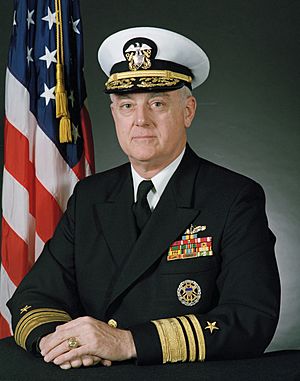John A. Baldwin Jr. facts for kids
Quick facts for kids
John A. Baldwin Jr.
|
|
|---|---|
 |
|
| Born | April 20, 1933 Baltimore, Maryland, U.S. |
| Allegiance | United States of America |
| Service/ |
United States Navy |
| Years of service | 1955-1992 |
| Rank | |
| Commands held | |
| Battles/wars | |
John Ashby Baldwin Jr. (born April 20, 1933) is a retired vice admiral of the United States Navy. He served during much of the Cold War. He commanded different types of ships, including destroyers. He also led a large group of ships called a carrier battle group.
Admiral Baldwin served in the Vietnam War. He also worked for important leaders like the Chief of Naval Operations and the Secretary of Defense. Later, he became the President of two major military colleges: the Naval War College and the National Defense University.
Contents
Early Life and Training
John Baldwin was born in Baltimore, Maryland. He finished high school at Kent School in 1950. Then, he graduated from the United States Naval Academy in 1955. This is where future Navy officers are trained.
After graduating, he became an ensign, which is a junior officer rank. He served on two destroyer ships: the USS Dennis J. Buckley (DD-808) and the USS Gainard (DD-706). He also received special training in Annapolis and Coronado.
From 1962 to 1964, he taught at the Naval Reserve Officer Training Corps (NROTC) at the University of Washington. While there, he studied oceanography, which is the science of the ocean.
Leading Ships and Missions
For the next seven years, Baldwin had important roles on several ships. He was the second-in-command (executive officer) of the destroyer USS Johnston (DD-821). He then became the main commander (commanding officer) of the USS Marysville (EPCER-857). He also commanded the destroyer escorts USS John R. Perry (DE-1034) and USS Meyerkord (DE-1058).
In 1971, Baldwin became a Senior Advisor in Vietnam during the Vietnam War. He worked with U.S. Naval Forces there. In 1973, he joined the Office of the Chief of Naval Operations (CNO) in Washington, D.C.. He helped plan how the Navy would operate.
From 1975 to 1977, he commanded Destroyer Division 33. This group included several destroyers.
Important Roles in Washington
After commanding ships, Baldwin returned to Washington, D.C. He worked in the office of the Secretary of the Navy. Then, he joined the staff of the Secretary of Defense. He was a military assistant to the Deputy Secretary of Defense.
From 1981 to 1982, he was the Director of the Systems Analysis Division for the CNO. This role involved studying and improving Navy systems.
Leading a Carrier Battle Group
From 1982 to 1986, Admiral Baldwin served in the Pacific. He commanded Cruiser-Destroyer Group 3. He also led the USS Kitty Hawk (CV-63) Carrier Battle Group. This huge group of ships sailed through the western Pacific and Indian Ocean.
In 1984, he became the Deputy Chief of Staff for Operations and Plans. This meant he helped plan missions for the entire United States Pacific Fleet.
Leading Military Colleges
From 1986 to 1987, Admiral Baldwin was the 44th President of the Naval War College in Newport, Rhode Island. This college provides advanced education for Navy officers. During his time there, he helped the college get approval to offer master's degrees. He also started the Institute for Strategic Studies and helped restore the college library after a fire.
His last job was as President of the National Defense University. He held this position for three years. This university provides high-level education for people in the Departments of Defense and State. Under his leadership, the university grew its teaching staff. He also helped the university get approval to award master's degrees.
Admiral Baldwin retired from active duty on October 1, 1992. He served the Navy for 37 years as a commissioned officer.

